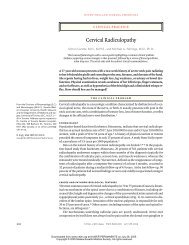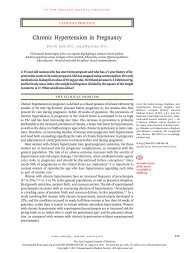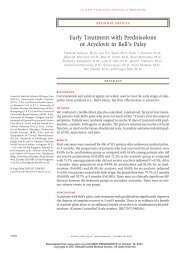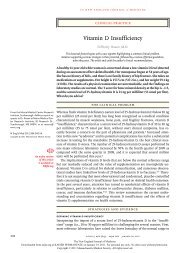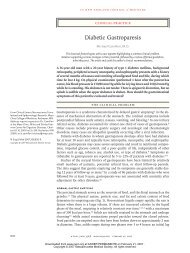Hypoparathyroidism - Q-Notes for Adult Medicine
Hypoparathyroidism - Q-Notes for Adult Medicine
Hypoparathyroidism - Q-Notes for Adult Medicine
Create successful ePaper yourself
Turn your PDF publications into a flip-book with our unique Google optimized e-Paper software.
clinical practice<br />
Syndrome of hypopara<br />
thyroidism,<br />
deafness, and<br />
renal anomalies<br />
Syndrome of hypoparathyroidism,<br />
growth<br />
and mental retardation,<br />
and<br />
dysmorphism<br />
DiGeorge, or velocardiofacial,<br />
syndrome<br />
10p14-10-<br />
pter,<br />
GATA3<br />
1q42-q43,<br />
TBCE<br />
22q11.2,<br />
TBX1<br />
Mitochondrial<br />
disorders with<br />
hypoparathyroidism<br />
Mitochondrial<br />
gene<br />
defects<br />
Autosomal<br />
dominant<br />
Autosomal<br />
recessive<br />
Heterozygous<br />
deletions of<br />
chromosome<br />
22q11.2 occurring<br />
mostly<br />
through<br />
new mutations<br />
Mutations or deletions that interfere with the ability<br />
of the transcription factor GATA3 to bind to DNA<br />
or interact with proteins that alter the expression<br />
of GATA3, a factor critical <strong>for</strong> parathyroid, kidney,<br />
and otic-vesicle development<br />
Mutations in TBCE causing loss of function and<br />
probably altered microtubule assembly in<br />
affected tissues<br />
Loss of function of genes on chromosome 22q11,<br />
most notably TBX1, a transcription factor responsible<br />
<strong>for</strong> regulating expression of other transcription<br />
and growth factors important in development<br />
of thymus and parathyroid glands; parathyroid<br />
and thymic defects are caused by abnormal<br />
development in third and fourth branchial<br />
pouches<br />
Maternal Deletions of varying size, mutations, rearrangements,<br />
and duplications in the mitochondrial<br />
genome<br />
Clinical features include hypoparathyroidism, bilateral<br />
sensorineural deafness (mild to profound), and renal<br />
anomalies or dysfunction<br />
Includes the Kenny–Caffey syndrome (short stature, osteosclerosis,<br />
cortical bone thickening, calcification of<br />
basal ganglia, ocular abnormalities, and hypoparathyroidism<br />
that is probably due to agenesis of the glands)<br />
and the Sanjad–Sakati syndrome (parathyroid aplasia,<br />
growth failure, ocular mal<strong>for</strong>mations, microencephaly,<br />
and retardation)<br />
Wide phenotypic spectrum; may include conotruncal cardiac<br />
defects, parathyroid and thymic hypoplasia, neurocognitive<br />
problems, and palatal, renal, ocular, and<br />
skeletal anomalies; hypocalcemia (in 50–60% of patients)<br />
can be transient or permanent and can develop<br />
in adulthood; microarray analysis per<strong>for</strong>med as an initial<br />
diagnostic screening test, with the deletion confirmed<br />
by FISH<br />
Syndromes include the Kearns–Sayre syndrome (progressive<br />
external ophthalmoplegia, pigmentary retinopathy,<br />
heart block or cardiomyopathy, diabetes, and hypoparathyroidism);<br />
MELAS with diabetes and hypoparathyroidism;<br />
and MTPDS, a disorder of fattyacid<br />
oxidation associated with peripheral neuropathy,<br />
retinopathy, acute fatty liver in pregnancy, and hypoparathyroidism<br />
Thakker, 2 Goltzman<br />
and Cole, 3 Van<br />
Esch et al., 22<br />
Ali et al. 23<br />
Thakker, 2 Parvari<br />
et al., 36,37 Sanjad<br />
et al. 38<br />
Kobrynski and<br />
Sullivan, 39 Zweier<br />
et al., 40 Goldmuntz<br />
41<br />
Thakker, 2 Cassandrini<br />
et al., 42<br />
Labarthe et al. 43<br />
* AIRE denotes autoimmune regulator protein, APS-1 autoimmune polyendocrine syndrome type 1, CaSR extracellular calcium-sensing receptor, FISH fluorescence in situ hybridization,<br />
GCMB glial cells missing B, MELAS mitochondrial encephalopathy, lactic acidosis, and strokelike episodes, MTPDS mitochondrial trifunctional protein deficiency syndrome, NALP5<br />
NACHT leucine-rich-repeat protein 5, pre-proPTH pre-proparathyroid hormone, PTH parathyroid hormone, SOX3 Sry-box 3, TBCE tubulin chaperone E, and TBX1 T-box transcription<br />
factor 1.<br />
† Cases that include Bartter’s syndrome are caused by certain activating CaSR mutations (K29E, L125P, C131W, and A843E). Data are from Egbuna and Brown. 11 These mutant CaSRs<br />
are thought to inhibit the activity of a renal outer medullary potassium channel responsible <strong>for</strong> maintaining the transepithelial voltage gradient in the loop of Henle.<br />
‡ Manifestations in a large Finnish cohort of patients included candidiasis (median age at onset, 5.4 years [range, 0.2 to 31.0]), hypoparathyroidism (6 years [1.6–43.0]), and adrenal insufficiency<br />
(10 years [3.5 to 41.0]); data are from Perheentupa. 34<br />
n engl j med 359;4 www.nejm.org july 24, 2008 397<br />
Downloaded from www.nejm.org at KAISER PERMANENTE on July 23, 2008 .<br />
Copyright © 2008 Massachusetts Medical Society. All rights reserved.






